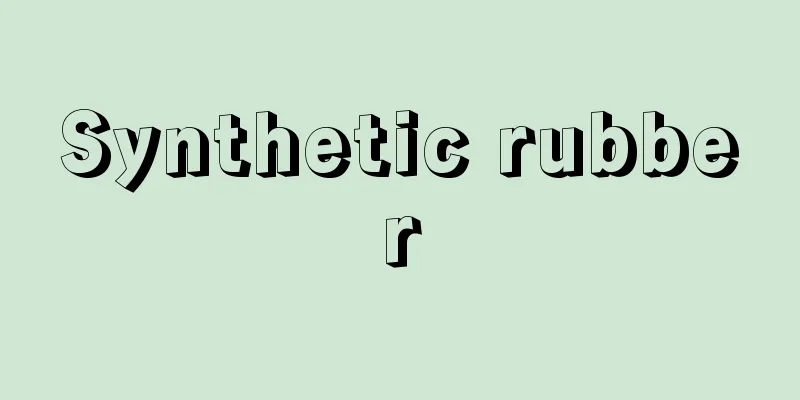Synthetic rubber

|
In contrast to natural rubber (NR), this is a general term for artificially synthesized rubber-like substances or rubber elastomers, and the synthetic polymer compounds that are the raw materials for these. While natural rubber is mainly composed of cis-1,4-polyisoprene, synthetic rubber comes in many varieties due to the diversity of raw materials and manufacturing methods, and exhibits distinctive properties according to its chemical structure. Synthetic rubber is manufactured to improve physical properties that natural rubber lacks, such as oil resistance, heat resistance, and ozone resistance. [Kazuyoshi Fukuda] historyIn 1826, British scientist Faraday discovered that the main component of natural rubber is C5H8 , the same as isoprene. In 1860, Charles Greville Williams (1829-1910) isolated isoprene by dry distillation of natural rubber and discovered that it is a structural unit. Since then, attempts to create synthetic rubber have continued. In the second half of the 19th century, natural rubber production centers were concentrated in areas mainly in Southeast Asia, and countries began to experience shortages of rubber resources due to weather and war. Attempts were made to produce synthetic rubber as a substitute for natural rubber, and by the beginning of the 20th century, the synthesis of a rubber-like substance similar to natural rubber had been established through research. During World War I, Germany, which was blockaded by the Allied forces, produced methyl rubber for the first time in 1914 using dimethylbutadiene as a raw material. This was the world's first industrialized synthetic rubber. However, its performance for automobile tires and other products was inferior to that of natural rubber products, and production was halted at the end of the war. In 1927, Buna (meaning the polymerization of butadiene using sodium) was industrialized by polymerization of butadiene with a sodium catalyst. In the 1930s, the emulsion polymerization method was perfected, and the production of Buna S (a copolymer of butadiene and styrene) was industrialized in 1933, and Buna N (a copolymer of butadiene and acrylonitrile) in 1934. Meanwhile, in the United States, polysulfide rubber (trade name Thiokol) was developed as a special rubber in 1927, and the production of chloroprene synthetic rubber (trade name Neoprene) was industrialized in 1931. Entering World War II, the United States, which experienced a shortage of natural rubber resources, began producing general-purpose rubber such as GR-S (German Buna S; GR is an abbreviation for government rubber) and GR-A (Buna N) under government control, and annual production reached 820,000 tons in 1945. After the war, these were transferred to private companies, and GR-S was renamed SBR, and GR-A was renamed NBR. In addition to Germany and the United States, production of synthetic rubber also began in Canada, France, the Soviet Union, and other countries. Due to a shortage of natural rubber and an increase in demand for rubber for automobile tires, the production of synthetic rubber increased rapidly after World War II and has continued to grow to this day. This was based on the development of the petrochemical industry and the progress of the polymer chemical industry, and in 1962 the production of synthetic rubber was on par with that of natural rubber. Since then, the growth in the production of synthetic rubber has always exceeded that of natural rubber. The number of types of synthetic rubber has increased, and in 1954, the United States was the first to successfully synthesize cis-1,4-polyisoprene, which has the same chemical structure as natural rubber (synthetic natural rubber). In this way, the synthetic rubber industry was founded on a solid foundation in terms of both quality and quantity, and this has led to the prosperity we see today. In Japan, production of SBR began in 1959 (Showa 34) with the birth of the petrochemical industry. Since then, the total production volume of various synthetic rubbers exceeded 1 million tons in 1978 and 1.6 million tons in 2004 (Heisei 16). This is 13% of the world production volume of 12 million tons in the same year. [Kazuyoshi Fukuda] Manufacturing method and characteristicsThe basic structure of synthetic rubber products is a high molecular weight linear polymer that has been appropriately crosslinked; it is amorphous and has a low glass transition temperature. Raw rubber is produced by polymerizing petrochemical monomers. Synthetic rubber products exhibit distinctive physical properties depending on the type of raw rubber and the crosslinking method. The general processing method for synthetic rubber is the same as for natural rubber, in which the raw rubber is (1) masticated to increase its plasticity and adhesion, (2) mixed with various compounding agents and kneaded, (3) molded into various desired objects, and (4) heated and vulcanized to produce rubber products. Vulcanization can be done with sulfur, peroxides, or metal oxides, depending on the structure of the raw rubber. Depending on the type, synthetic rubber has several particularly excellent properties, such as elasticity, abrasion resistance, heat resistance, aging resistance, cold resistance, ozone resistance, oil resistance, and chemical resistance, and is used in a wide range of applications. [Kazuyoshi Fukuda] kindsSynthetic rubbers are classified into diene (R), olefin (M), polysulfide (T), silicone (Q), fluorine (FK-), urethane (U), and ether (O) types based on their chemical structure. They are usually solid rubbers, but latex and liquid rubbers are also available. They are classified into general-purpose rubbers, which are used in large quantities in tires, and special rubbers for industrial and medical use. General-purpose rubbers include styrene-butadiene rubber (SBR), butadiene rubber (BR), and isoprene rubber (IR), of which IR is produced in small quantities. Specialty rubbers include semi-general-purpose ethylene-propylene-diene rubber (EPDM), chloroprene rubber (CR), and acrylonitrile-butadiene rubber (NBR). New types of rubber include physically crosslinked thermoplastic elastomers (thermoplastic rubbers) and liquid rubbers, which are cured by chain-extension crosslinking. The abbreviations in parentheses are those of ASTM International (formerly the American Society for Testing and Materials), an international standardization and standards setting organization. (1) Styrene-butadiene rubber (SBR) This is the most common type of rubber and is produced in the greatest volume. Most of it is synthesized by emulsion polymerization and is abbreviated as E-SBR, while some are synthesized by solution polymerization and is abbreviated as S-SBR. Normally, E-SBR is a random copolymer obtained by low-temperature radical copolymerization of styrene (23.5%) and butadiene. SBR that contains more than 50% styrene is called high styrene rubber and is used in hard rubber products such as shoe soles and floor tiles. SBR latex is a rubber emulsion that is concentrated after the emulsion polymerization is stopped and stabilizers are added. (2) Butadiene rubber (BR) There are high cis BR and low cis BR. High cis BR is synthesized by solution polymerization of butadiene with a Ziegler catalyst, and is a stereoregular polymer with 96% or more cis-1,4 bonds. It is the second most commonly used general-purpose rubber after SBR. Low cis BR (10-35% cis-1,4 bonds, 57-66% trans-1,4 bonds) is a general-purpose rubber manufactured by solution polymerization or emulsion polymerization with a lithium catalyst. Of these, emulsion polymerization method low cis BR is used as a latex for ABS resin. Depending on the type of Ziegler catalyst, stereoregular polymers such as high trans BR and high 1,2 BR can be produced. (3) Chloroprene rubber (CR) Synthesized by emulsion polymerization of chloroprene, it contains more than 80% trans-1,4 bonds. It is cross-linked with magnesium oxide or zinc oxide to make rubber products. It is flame retardant, has excellent oil and weather resistance, and has well-balanced physical properties overall. It crystallizes easily and has good adhesive properties when used as rubber paste. (4) Acrylonitrile-butadiene rubber (NBR) Produced by emulsion polymerization of acrylonitrile (15-50%) and butadiene (85-50%). Vulcanized rubber products are particularly oil-resistant, and the higher the acrylonitrile content, the higher the oil resistance. It is inferior to natural rubber in terms of flex crack resistance, ozone resistance, and electrical insulation. (5) Isoprene rubber (synthetic natural rubber, IR) Polyisoprene with 94% or more cis-1,4 bonds and the same chemical structure as natural rubber. It is synthesized by solution polymerization of isoprene using a Ziegler catalyst or an alkyl lithium catalyst. It exhibits almost the same properties as natural rubber, but the strength of unvulcanized rubber is low, making it unsuitable for heavy-duty tires for trucks and aircraft. (6) Butyl rubber (IIR) It is synthesized by adding about 3% isoprene to isobutylene and polymerizing it at low temperature with aluminum chloride catalyst, etc. Vulcanized rubber products have low gas permeability (one-tenth that of natural rubber) and low impact elasticity. (7) Ethylene-propylene rubber (EPM/EPDM) Ethylene-propylene (6:4 to 7:3) copolymer (EPM) and ternary copolymer (EPDM) with 5% or less of non-conjugated diene (e.g. ethylidene norbornene) added to both monomers. Both are synthesized by solution polymerization using Ziegler catalyst. EPDM is popular as a semi-general-purpose rubber, and rubber products can be made by normal vulcanization. (8) Ethylene-vinyl acetate rubber (EVM) is a copolymer of ethylene and vinyl acetate (25-40%). When the vinyl acetate content is low, it is a thermoplastic elastomer, but when the content is high, it can be crosslinked with peroxide. It does not have good cold resistance. (9) Acrylic rubber (ACM) A synthetic rubber whose main component is acrylic ester. Typical examples are copolymers with 2-chloroethyl vinyl ether or allyl glycidyl ether. It is crosslinked with amines, but there are also types that are vulcanized with sulfur. (10) Fluorine rubber (FKM) is a general term for synthetic rubber that contains fluorine. A typical example is a copolymer of vinylidene fluoride and propylene hexafluoride or propylene pentafluoride. It has the best heat resistance, oil resistance, and chemical resistance of any rubber, but is expensive. (11) Polyether rubber (O) A general term for synthetic rubber with an ether bond in the main chain. It is also called hydrin rubber. Epichlorohydrin polymer (CO) and epichlorohydrin-ethylene oxide copolymer (ECO) are typical examples. Products are made by crosslinking with diamines or peroxides. It has excellent oil resistance, heat resistance, ozone resistance, and low-temperature properties. It is used industrially for automobile and aircraft parts. (12) Chlorosulfonated polyethylene (CSM) is a synthetic rubber made by reacting polyethylene with chlorine and sulfur, partially replacing the chlorine and sulfuryl chloride groups. It is cross-linked with metal oxide to make a product. Since it has no unsaturated bonds, it has excellent ozone resistance, heat aging resistance, and chemical resistance. (13) Polysulfide rubber (T) is a general term for synthetic rubbers whose main chain has polysulfide bonds -Sn- (n = 2 to 4). They are synthesized by polycondensation of organic dichlorides such as bis(2-chloroethoxy)methane and sodium polysulfide. They are cross-linked with metal oxides to produce products. (14) Urethane rubber (U) Polyurethane is a prepolymer synthesized by the polyaddition reaction of polyether diol or polyester diol with hydroxyl groups at both ends with diisocyanate, and is abbreviated as EU and AU, respectively. Chain extenders and crosslinkers are added to this and molded into a product. Depending on the molding method, it can be divided into three types: (a) cast type, which is molded by casting, (b) millable type, which is processed like normal rubber, and (c) thermoplastic type, which is injection molded. Type (a) is the most common, and the prepolymer is liquid, so it is called liquid rubber. Type (c) is a long-chain polyurethane, and is called a thermoplastic elastomer. (15) Silicone rubber (Q) Among linear polymers with organosiloxane bond -Si(R,R')-O- units, the raw material rubber is a semi-fluid solid. It is crosslinked with organic peroxides, or if it contains vinyl side chains, it is vulcanized with sulfur to produce the finished product. It has the same main chain as inorganic glass, and is elastic even at low temperatures, so it can be used in a wide temperature range. (16) Others There are diene rubbers such as alternating copolymers of propylene and butadiene (alternating PBR), copolymers of acrylonitrile and isoprene (NIR), polyalkenamer rubbers synthesized by ring-opening polymerization of cycloolefins, and polythioether rubbers synthesized by ring-opening copolymerization of ethylene sulfide and propylene sulfide. [Kazuyoshi Fukuda] Thermoplastic elastomer (thermoplastic rubber)It is a general term for rubber with physical crosslinks that softens and can be molded when heated, but exhibits mechanical properties similar to those of ordinary rubber at room temperature. It is called a thermoplastic elastomer because it exhibits thermoplastic properties like plastics. A representative example is an ABA block copolymer. For example, the A block is a hard segment like polystyrene, and the B block is a soft segment like polybutadiene. The B block, which is made of flexible molecular chains with a molecular weight of several thousand, is the part that exhibits the properties of rubber, and the hard A block aggregates at both ends form physical crosslinks through intermolecular cohesive forces. It exhibits fluidity when heated above the softening temperature of the A block. While it has the advantages of being a thermoplastic polymer, it has poor heat resistance and solvent resistance. In addition to the ABA triblock or teleblock type mentioned above, there is also the (BA)n multiblock type ( ). [Kazuyoshi Fukuda] Liquid RubberThe raw material is a liquid prepolymer (also called a telechelic polymer) with a molecular weight of several thousand, high flexibility, and functional groups such as hydroxyl groups and amino groups at both ends, to which a multifunctional compound is added to extend the chain and crosslink to produce a rubber product. This type of rubber is collectively called liquid rubber. It is easy to process and can be used as a sealant for complex molded objects and narrow spaces ( ). [Kazuyoshi Fukuda] The future of synthetic rubberIn this way, many new types of synthetic rubber have been developed due to the diversity of raw materials, polymerization methods, and vulcanization methods. Of these, general-purpose rubbers include SBR and BR, with EPDM now being added. The uses of specialty rubber are expanding with the development of the machinery, automotive, and electrical and electronics industries, and new types can continue to be developed in the future. For example, functional synthetic rubbers such as photosensitive, conductive, magnetic, and biocompatible rubbers are being produced, and pressurized conductive rubber is used in the switches of electronic devices and cameras. [Kazuyoshi Fukuda] "Actual Knowledge of Rubber" by Harumi Asai (1974, Toyo Keizai Shinposha)" ▽ "Industrial Chemistry Series Rubber" by Junichi Yamada, edited by the Chemical Society of Japan (1975, Dainippon Tosho)" ▽ "Rubber and Elastomers" by Yasuyuki Tanaka and Harumi Asai (1993, Dainippon Tosho)" [Reference items] | | | | | | | | | | | | | | | | | | | |©Shogakukan "> Standard SBR mix ©Shogakukan "> Polymerization methods and chemical structures of major synthetic rubbers (1) ©Shogakukan "> Polymerization methods and chemical structures of major synthetic rubbers (2) ©Shogakukan "> Properties and uses of major synthetic rubbers (1) ©Shogakukan "> Properties and uses of major synthetic rubbers (2) ©Shogakukan "> Thermoplastic elastomer (thermoplastic rubber)… ©Shogakukan "> Molecular structure of liquid rubber (Figure B) Source: Shogakukan Encyclopedia Nipponica About Encyclopedia Nipponica Information | Legend |
|
天然ゴム(NR)に対して、人工的に合成されたゴム状物質あるいはゴム弾性体、およびそれらの原料である合成高分子化合物の総称。天然ゴムが主成分シス-1,4-ポリイソプレンであるのに対して、合成ゴムは原料および製造法の多様性のために多くの種類があり、その化学構造に従って特徴のある性質を示す。天然ゴムに乏しい耐油性、耐熱性、耐オゾン性などの物性を改良した合成ゴムが製造されている。 [福田和吉] 歴史1826年イギリスのファラデーは、天然ゴムの主成分がイソプレンと同じC5H8であることを明らかにした。1860年ウィリアムスCharles Greville Williams(1829―1910)は天然ゴムの乾留によってイソプレンを単離し、構造単位であることを明らかにした。それ以来、合成ゴムをつくる試みが続けられた。19世紀後半に天然ゴムの生産地が東南アジアを中心とした地域に集まり、天候や戦争によってゴム資源の不足する国々が現れた。天然ゴム代替を目的として合成ゴムの製造が試みられ、20世紀初めには天然ゴム類似のゴム状物質の合成が、研究上確立された。 第一次世界大戦中、連合軍によって封鎖されたドイツは、1914年ジメチルブタジエンを原料にしてメチルゴムの製造を初めて行った。これが世界初の工業化された合成ゴムである。しかし、自動車用タイヤなどの性能が天然ゴム製品に比べて劣り、戦争終了とともに生産は中止された。1927年にはブタジエンのナトリウム触媒による重合でブナBuna(ナトリウムnatriumを用いブタジエンbutadienを重合するの意)の工業化が行われた。1930年代に入り乳化重合法が完成して、1933年ブナS(ブタジエンとスチレンとの共重合体)と、1934年ブナN(ブタジエンとアクリロニトリルとの共重合体)の製造が工業化した。一方、アメリカでは特殊ゴムとして1927年多硫化系ゴム(商品名チオコール)が開発され、1931年クロロプレン系合成ゴム(商品名ネオプレン)の製造が工業化された。第二次世界大戦に入り天然ゴム資源の欠乏したアメリカは、政府の管理下にGR-S(ドイツのブナSのこと。GRは政府のゴムgovernment rubberの略)とGR-A(ブナN)など汎用(はんよう)ゴムの生産を開始、1945年には年産82万トンに達した。戦後、これらは民間企業に移され、GR-SはSBR、GR-AはNBRの略称に変えられている。ドイツやアメリカのほかカナダ、フランス、ソ連などの各国でも合成ゴムの製造が開始された。 天然ゴムの不足と自動車のタイヤ用ゴムの需要の増大に伴って、合成ゴム生産量は第二次世界大戦後急増して今日に至っている。その基礎は石油化学工業の発展と高分子化学工業の進歩にあり、合成ゴム生産量は1962年には天然ゴム生産量と並んだ。その後の合成ゴム生産量の増加はつねに天然ゴムより上回っている。合成ゴムの種類も多くなり、1954年にはアメリカで初めて天然ゴムと同じ化学構造をもったシス-1,4-ポリイソプレンの合成(合成天然ゴム)に成功した。このように合成ゴム工業は質・量ともに確固たる基盤のうえにたち、今日の隆盛を築いた。 日本では石油化学工業の誕生とともに1959年(昭和34)にSBRの生産が開始されて以来、各種合成ゴム生産量の合計は1978年に100万トン、2004年(平成16)に160万トンを超えた。これは同年の世界の生産量1200万トンの13%にあたる。 [福田和吉] 製造法と特性合成ゴム製品の基本的な構造は、高分子量の線状高分子が適当な架橋をしたものであり、非晶性でガラス転移温度が低い。原料ゴムは石油化学製品のモノマー(単量体)を重合して製造される。合成ゴム製品は原料ゴムの種類と架橋方法によって、特徴のある物性を示す。一般的な合成ゴムの加工法は天然ゴムと同じで、原料ゴムを(1)可塑性と粘着性を高めるために素練りをし、(2)各種配合剤を混合して混練り後、(3)各種目的物に成形、(4)加熱加硫してゴム製品とする。加硫は原料ゴムの構造に依存して、硫黄(いおう)によるほか、過酸化物や金属酸化物による場合もある。 合成ゴムはその種類によって、弾性、耐摩耗性、耐熱性、耐老化性、耐寒性、耐オゾン性、耐油性、耐薬品性などの性質のいくつかがとくに優れており、広範囲に使われている。 [福田和吉] 種類合成ゴムの種類は化学構造の違いからジエン系(R)、オレフィン系(M)、多硫化系(T)、シリコーン系(Q)、フッ素系(FK-)、ウレタン系(U)、およびエーテル系(O)などに分類される。通常、固形ゴムであるが、ラテックスや液状ゴムがある。用途別にはタイヤなどに多量に使われる汎用ゴムと、工業用や医療用の特殊ゴムに分類される。汎用ゴムはスチレン・ブタジエンゴム(SBR)、ブタジエンゴム(BR)、およびイソプレンゴム(IR)であり、このうちIRの生産量は少ない。特殊ゴムは準汎用のエチレン・プロピレン・ジエンゴム(EPDM)、クロロプレンゴム(CR)およびアクリロニトリル・ブタジエンゴム(NBR)などである。新しいタイプのゴムとして、物理的橋架けの熱可塑性エラストマー(熱可塑性ゴム)および鎖延長橋架けによって硬化する液状ゴムがある。カッコ内は、国際標準化・規格設定機関であるASTMインターナショナル(旧アメリカ材料試験協会)による略称。 (1)スチレン・ブタジエンゴム(SBR) 汎用ゴムの代表として、もっとも大量に生産されている。大部分は乳化重合によって合成され、E-SBRと略称、一部は溶液重合によって合成され、S-SBRと略称。通常、E-SBRは、スチレン(23.5%)とブタジエンの低温ラジカル共重合によって得られるランダム共重合体である。スチレンを50%以上含むSBRはハイスチレンゴムとよばれ、硬質ゴム製品の靴底や床タイルなどの用途がある。SBRラテックスは、乳化重合を停止した後濃縮して安定剤を加えたゴムの乳濁液である。 (2)ブタジエンゴム(BR) 高シスBRと低シスBRがある。高シスBRは、ブタジエンのツィーグラー(チーグラー)系触媒による溶液重合で合成され、シス-1,4結合が96%以上の立体規則性ポリマーである。汎用ゴムとしてSBRに次いで多く使われる。低シスBR(シス-1,4結合10~35%、トランス-1,4結合57~66%)はリチウム系触媒の溶液重合あるいは乳化重合によって製造される汎用ゴムである。このうち乳化重合法低シスBRはラテックスとしてABS樹脂用に使われる。また、ツィーグラー系触媒の種類によって高トランスBRや高1,2BRなどの立体規則性ポリマーができる。 (3)クロロプレンゴム(CR) クロロプレンの乳化重合で合成され、トランス-1,4結合を80%以上含む。酸化マグネシウムや酸化亜鉛で架橋してゴム製品とする。難燃性であり、耐油性・耐候性に優れ、全体的に物性が均衡のとれた性質であり、結晶化しやすく、ゴム糊(のり)としたときの接着性がよい。 (4)アクリロニトリル・ブタジエンゴム(NBR) アクリロニトリル(15~50%)とブタジエン(85~50%)の乳化重合によって製造される。加硫ゴム製品はとくに耐油性が優れており、アクリロニトリル含有量の多いほど耐油性が高くなる。天然ゴムより、耐屈曲亀裂(きれつ)性、耐オゾン性、電気絶縁性などは劣る。 (5)イソプレンゴム(合成天然ゴム、IR) シス-1,4結合が94%以上のポリイソプレンであり、天然ゴムと同じ化学構造をもつ。ツィーグラー系触媒あるいはアルキルリチウム触媒によるイソプレンの溶液重合で合成される。天然ゴムとほとんど同じ性質を示すが、未加硫ゴムの強度が低く、トラックや航空機用の重負荷タイヤには適さない。 (6)ブチルゴム(IIR) イソブチレンに3%程度のイソプレンを加え、塩化アルミニウム触媒などにより低温溶液重合して合成される。加硫ゴム製品は気体透過性が天然ゴムの10分の1と低く、反発弾性が低い。 (7)エチレン・プロピレンゴム(EPM・EPDM) エチレンとプロピレン(6対4~7対3)の共重合体(EPM)および両モノマーに5%以下の非共役ジエン(たとえばエチリデンノルボルネン)を加えた三成分共重合体(EPDM)である。いずれもツィーグラー系触媒による溶液重合で合成される。EPDMは準汎用ゴムとして普及し、通常の加硫によってゴム製品ができる。 (8)エチレン・酢酸ビニルゴム(EVM) エチレンと酢酸ビニル(25~40%)の共重合体である。酢酸ビニル組成の低いときは熱可塑性エラストマーであり、高くなると過酸化物で架橋することができる。耐寒性があまりよくない。 (9)アクリルゴム(ACM) アクリル酸エステルを主成分とする合成ゴムである。2-クロロエチルビニルエーテルあるいはアリルグリシジルエーテルとの共重合体が代表的である。アミン類で架橋するが、硫黄で加硫するタイプもある。 (10)フッ素ゴム(FKM) フッ素を含む合成ゴムの総称である。フッ化ビニリデンと六フッ化プロピレンあるいは五フッ化プロピレンの共重合体が代表である。耐熱性、耐油性、耐薬品性がゴムのなかでもっとも優れているが、高価である。 (11)ポリエーテルゴム(O) 主鎖がエーテル結合をもつ合成ゴムの総称。ヒドリンゴムともよばれる。エピクロロヒドリン重合体(CO)とエピクロロヒドリン‐エチレンオキシド共重合体(ECO)が代表的である。ジアミンや過酸化物で架橋して製品とする。耐油性、耐熱性、耐オゾン性、低温物性が優れている。工業用として自動車や航空機の部品に使われる。 (12)クロロスルホン化ポリエチレン(CSM) ポリエチレンに塩素と硫黄を反応させ、部分的に塩素と塩化スルフリル基を置換した合成ゴムである。金属酸化物で架橋して製品とする。不飽和結合がないので、耐オゾン性、耐熱老化性、耐薬品性などが優れている。 (13)多硫化系ゴム(T) 主鎖がポリスルフィド結合-Sn-(n=2~4)をもつ合成ゴムの総称。ビス(2-クロロエトキシ)メタンのような有機二塩化物と多硫化ソーダの重縮合で合成される。金属酸化物で架橋して製品とする。 (14)ウレタンゴム(U) 両末端にヒドロキシ基をもつポリエーテルジオールあるいはポリエステルジオールとジイソシアナートの重付加反応によって合成されるポリウレタンがプレポリマーであり、それぞれEUおよびAUと略称される。これに鎖延長・橋架け剤を加えて成形し、製品とする。成形法によって、(a)注形加工するキャストタイプ、(b)通常のゴムのように加工するミラブルタイプ、および(c)射出成形加工する熱可塑性タイプの3種類に分けられる。(a)のタイプがもっとも多く、プレポリマーが液状であり、液状ゴムとよばれる。(c)のタイプは長鎖状のポリウレタンであり、熱可塑性エラストマーとよばれる。 (15)シリコーンゴム(Q) オルガノシロキサン結合-Si(R,R')-O-の単位をもつ線状重合体のうち、半流動性の固体が原料ゴムである。有機過酸化物で架橋するか、ビニル基側鎖を含むものは硫黄で加硫して製品とする。無機のガラスと同じ主鎖をもち、低温でも弾性を示すので使用温度範囲が広い。 (16)その他 プロピレンとブタジエンの交互共重合体(交互PBR)、アクリロニトリルとイソプレンの共重合体(NIR)などのジエン系ゴムがあり、シクロオレフィンの開環重合によって合成されるポリアルケナマーゴムもある。また、エチレンスルフィドとプロピレンスルフィドの開環共重合によって合成されるポリチオエーテルゴムがある。 [福田和吉] 熱可塑性エラストマー(熱可塑性ゴム)加熱すると軟化して成形できるが、室温付近では通常のゴムと同様の力学的性質を示す、物理的な架橋をもつゴムの総称である。プラスチックのように熱可塑性を示すことから、熱可塑性エラストマーとよばれる。代表的なものはABA形ブロック共重合体である。たとえばAブロックはポリスチレンのようなハードセグメント、Bブロックはポリブタジエンのようなソフトセグメントである。分子量が数千程度の屈曲性をもつ柔軟な分子鎖からなるBブロックがゴムの性質を現す部分であり、その両末端の硬いAブロック集合部が分子間凝集力によって物理的架橋点をつくる。加熱してAブロックの軟化温度以上になれば流動性を示す。熱可塑性ポリマーとしての利点をもつ反面、耐熱性と耐溶剤性が劣る。前記のABAトリブロックあるいはテレブロック体のほか(BA)nマルチブロック体がある()。 [福田和吉] 液状ゴム分子量が数千程度で屈曲性が高く、両末端にヒドロキシ基やアミノ基などの官能基をもつ液状のプレポリマー(テレキリックポリマーともいう)が原料であり、これに多官能性化合物を加えて鎖延長と架橋を行ってゴム製品とする。このようなゴムを総称して液状ゴムという。成形加工が容易であり、複雑な成形物や狭い空間のシーリング材として利用できる()。 [福田和吉] 合成ゴムの将来このように合成ゴムは、原料と重合法、さらに加硫法などの多様性のために多くの新しい種類が開発されてきた。このうち汎用ゴムはSBRとBRにEPDMが加わってきた。機械工業、自動車工業、電気電子産業などの発展とともに用途が拡大している特殊ゴムは、今後も新しい種類の開発が可能である。たとえば、感光性、導電性、磁性あるいは生体適合性などの機能性合成ゴムがつくられており、加圧導電性ゴムは電子機器やカメラのスイッチに使われている。 [福田和吉] 『浅井治海著『ゴムの実際知識』(1974・東洋経済新報社)』▽『山田準吉著、日本化学会編『産業化学シリーズ ゴム』(1975・大日本図書)』▽『田中康之・浅井治海著『ゴム・エラストマー』(1993・大日本図書)』 [参照項目] | | | | | | | | | | | | | | | | | | | |©Shogakukan"> SBRの標準配合 ©Shogakukan"> おもな合成ゴムの重合法と化学構造(1) ©Shogakukan"> おもな合成ゴムの重合法と化学構造(2) ©Shogakukan"> おもな合成ゴムの性質と用途(1) ©Shogakukan"> おもな合成ゴムの性質と用途(2) ©Shogakukan"> 熱可塑性エラストマー(熱可塑性ゴム)の… ©Shogakukan"> 液状ゴムの分子構造〔図B〕 出典 小学館 日本大百科全書(ニッポニカ)日本大百科全書(ニッポニカ)について 情報 | 凡例 |
Recommend
Tamotsu Irie
Binpo no ho, a vassal of the shodenryo (Binpo offi...
vertebral column
…the olecranon, capitellum, and styloid process a...
Nail polish
…Originally, mani comes from the Latin manus, whi...
Etatisme - Etatisme
Please see the "Nationalism" page. Sour...
Kula - Kura (English spelling) kula
A ritual exchange practiced by the Melanesians. T...
German Democratic Republic
A republic that existed in the northeastern part ...
Reverse interest - Gyakuhibu
This refers to the daily interest rate charged in...
Christian Ditlev Reventlov
1748‐1827 A Danish politician and a large land-own...
unskilled worker
… [History] Before the Industrial Revolution, sel...
Educational Counseling - Educational Counseling
Advising the child or student on the best way to ...
Khorramshahr (English spelling)
Until 1924, it was called Muhammara. It is a port ...
Triton
The development code name for the 430FX, a chipset...
Dry Fog - Kanmu
Fog made up of tiny droplets that won't get yo...
Pharmacology - pharmacology
It is a science that studies how chemical substan...
Baroque Music
A period of European music from the end of the 16...









